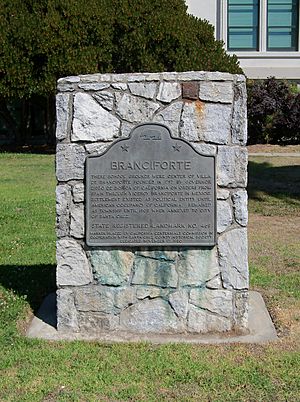Branciforte facts for kids
Quick facts for kids Villa de Branciforte |
|
|---|---|
 |
|
| Location | Santa Cruz, California |
| Reference no. | 469 |
| Lua error in Module:Location_map at line 420: attempt to index field 'wikibase' (a nil value). | |
Branciforte, first known as Villa de Branciforte, was the last of only three special towns, called pueblos, built by the Spanish government in Alta California. These towns were different because they were not controlled by the church or the military. The Villa de Branciforte was started in 1797. It was built on the east side of the San Lorenzo River, across from Mission Santa Cruz. This town never really grew as planned. In 1905, the area became part of the city of Santa Cruz, California.
Today, the Branciforte Small Schools Campus (BSSC) building stands where the center of Villa de Branciforte used to be. A special marker, number 469, from California State history is outside the building. You can find it at the corner of Water Street and Branciforte Avenue.
Contents
History of Branciforte
Villa de Branciforte was founded under the direction of California Governor Diego de Borica. It was named in honor of Miguel de la Grúa Talamanca, 1st Marquis of Branciforte, who was a very important leader in New Spain. Spain created this town to help protect California from other European countries. These included countries like Russia, England, and France. Unlike the Spanish missions, this town was meant for regular people, not for the church or military.
In 1781, Governor Felipe de Neve had made rules for how these special towns should be run. These rules were called "Regulations for the Government of the Province of the Californias." They said that towns could elect their own leaders. These leaders included an alcalde, who was like a mayor and a judge. There was also an ayuntamiento, which was a town council. Other roles included a juez de paz, or justice of the peace.
Challenges from the Start
From the very beginning in 1797, Villa de Branciforte faced many problems. There was not enough money to build the town properly. Also, not many retired soldiers wanted to move there. Instead, the first group of settlers were people who had been sent from prison in New Spain. The missionaries at Mission Santa Cruz were very unhappy about this new town being so close to their mission. However, the town still received official support from the government.
The first eight settlers came from Guadalajara, Jalisco, which was in New Spain (Spanish colonial Mexico). They arrived expecting to find a town already built for them. Instead, they found nothing ready. They had to build their own simple homes with very few tools or supplies. Because of these difficulties, Villa de Branciforte never looked like the neat town its planners had imagined. It also never met the hopes people had for it. By 1802, the Spanish Crown stopped sending money and supplies.
Early Government and Growth
In 1803, about five years after the town was started, the settlers tried to create their own government. They elected an alcalde, who was a local judge and leader. This election was one of the first elections ever held in Alta California. After this, the people of Villa de Branciforte began to spread out into the surrounding area.
There were also ongoing problems with the missionaries at the nearby Mission Santa Cruz. They argued about where animals could graze. The missionaries also worried that the settlers were a bad influence on the neophytes, who were new converts at the Mission. For the first few years, the number of people living in Branciforte actually went down.
The Bouchard Incident
In 1818, a pirate named Hippolyte Bouchard threatened to attack the California coast. He was helping countries in the Americas fight for their independence. The people of Branciforte were asked to help protect the Mission from being robbed. The padres (priests) and neophytes from the Mission went to other Missions further inland for safety. When Bouchard arrived, he did not attack Santa Cruz. Instead, it was the people from Branciforte who took many things from the Mission. They even took items from the church.
When the missionaries and neophytes came back, they found the whole place had been ransacked. It was soon discovered who had really taken the items. This event made the mistrust between the two communities even deeper.
By 1831, Branciforte had grown to about two hundred people. Most of these residents were merchants, explorers, and retired soldiers.
The Branciforte Adobe is the only building left from the original town of Branciforte. There are three other old adobe buildings in Santa Cruz County from that time.

